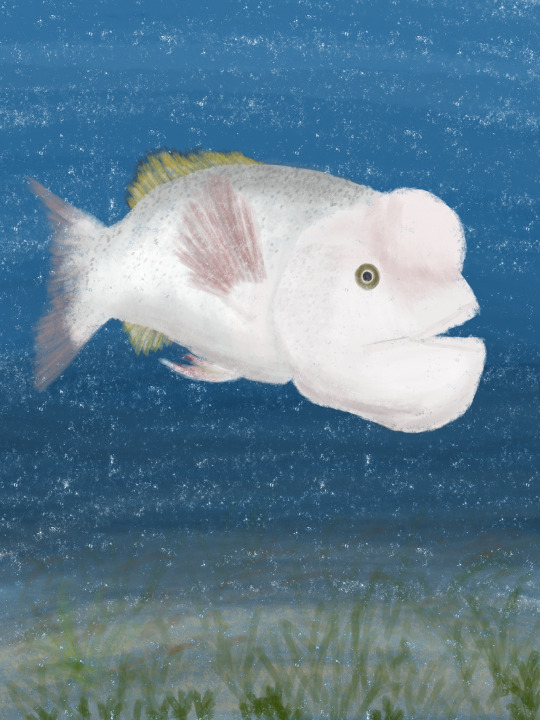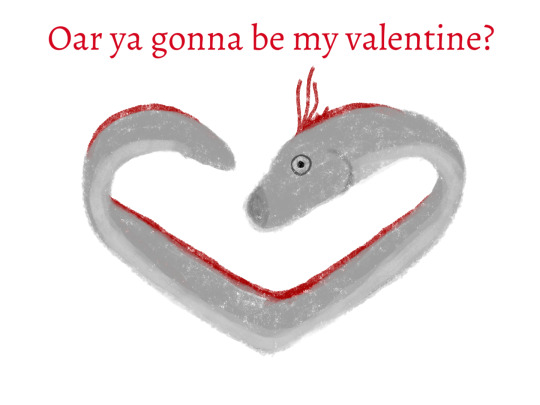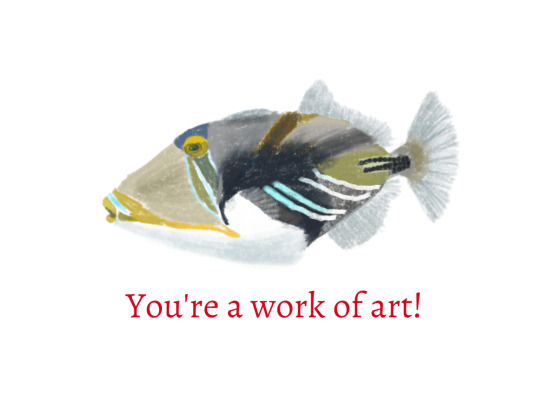#asian sheepshead wrasse
Text


❤️
6K notes
·
View notes
Video
Source
Full Video
1K notes
·
View notes
Text
🐠 Daily Fish Fact: 🐠
The Asian Sheepshead Wrasse is one of the largest species of wrasse, native to the western Pacific Ocean. It is a hermaphroditic species, meaning that it has both male and female organs which allows it to change its sex. All Sheepshead are born female and as they grow older, eventually will change sex.


#asian sheepshead wrasse#wrasse#weird fish#hermaphrodite#fish#fish post#daily fish#daily fish fact#fish facts#facts about fish#ocean#marine#marine fish#ocean fish#marine biology#marine life#marine animal#ocean life#respect the locals
57 notes
·
View notes
Text
Day 3 of @fish-daily 's fishuary: wrasse
I went with everyone's favorite Asian Sheepshead Wrasse

[Image ID: drawing of an Asian sheepshead wrass which is slightly pink with a bulging knob on its forehead. End ID]
#wrasse#Asian Sheepshead Wrasse#trans fish#this fish says trans rights#ugly affectionate#marine biology#there are many benefits to being a marine biologist#artist described#image id#art#illustration#illustrator
37 notes
·
View notes
Text

Happy pride month
#Bejdjxjs this is all I've got for yall#Thedeeps#Marine biology#Marine bio#pride month#Trans fish#What do I tag this as I don't fuckin know#Pride#Lgbt#Marine biology memes#The fish are#Clownfish#Asian Sheepshead wrasse#Black sea bass#Ribbon eel#Damselfish#For those curious
395 notes
·
View notes
Text

Inside the Ruins - Underwater Ruins of Mo'ia Atoll
Endless Ocean, Nintendo Wii
look at himb. he goin. patrolling, even
#endless ocean#endlessocean#forever blue#endlessoceanphotos#nintendo wii#wii#asian sheepshead wrasse#underwater ruins of mo'ia atoll
12 notes
·
View notes
Text

asian sheepshead wrasse got featured in documentary and I have been inspired
3K notes
·
View notes
Text

The Asian sheepshead wrasse, a very peculiar fish with a huge bump on the forehead.
The Asian sheepshead wrasse (Semicossyphus reticulatus), is a species of wrasse, one of the largest, native to the western Pacific Ocean, from around the Korean Peninsula, China, Japan, and the Ogasawara Islands.
This species is quite large in size and can reach a length of about 35.4 - 39.3 in (90 - 100 cm), with the greatest weight recorded as 14.7 kg (32 lb). It is also known as kobudai in Japan, and is a hermaphroditic species. All wrasses are born female and then according to the suitable situation, they can change their sex to male. They have a very prominent bulbous forehead and also visible teeth in the adult.
📷 Tony Wu
Source, Earth Unreal
311 notes
·
View notes
Note
I saw those tags. I can be trusted with the assortment of fish and reptile facts 👁️👁️
Fish facts from Fisch
Today I will tell you about the Asian sheepshead wrasse, the fancy science name being Semicossyphus reticulatus.

These fish are also called the Kobudai in Japan, a name that probably came from the big bump (Kobu) on their head. They live in rocky reef areas around Japan, China and Korea and are one of the biggest species in the Wrasse family (known for their big ol lips and jaw structures.)

One of the most interesting facts about Kobudai is how they can change their sex from female to male, this is thought to be done in order to double the fish's reproduction, and increase the odds of genes being passed down.

Kobudai said trans pride
Thats a basic little rundown of this fish, but feel free to look more into it with the links below!
If you want to learn more about the Asian sheepshead wrasse and other similar fish, you can read this article HERE or watch Blue Planet 2 which is where I first learned about it!
You can also read THIS article about Hiroyuki Arakawa, a scuba diver who has been friends with a Kobudai named Yoriko for more than a quarter of his life! (there's like a 2 minute video HERE as well if you don't like reading)
you can also get a rough understanding of these fish and other Wrasse off of its wikipedia entry HERE (actually a little barren here but there is some information on Wrasse)
#Ramble#Animals#Marine#trans pride#Trans#thank you for your interest in my facts hashi <3#Ive actually been waiting to make a lil post about this fish for pride month so thank you for the opportunity#fishblr#fish facts#marine biology#ocean#fish#fisch facts
53 notes
·
View notes
Text
day 23, 15/02/24 - fish of the day is the asian sheepshead wrasse (Semicossyphus reticulatus)

4 notes
·
View notes
Text

8 notes
·
View notes
Text

By: Colin Wright
Published: Feb 8, 2024
Biology is under siege from activists trying to undermine our long-established, universal understanding of what constitutes male and female organisms. These are not merely cloistered academic debates; this ideologically motivated pseudoscience is having a profound impact on society. It affects the existence of female-only spaces such as bathrooms, dressing rooms, rape shelters, and jails/prisons, as well as the safety and fairness of female-only sports leagues and events. It also shapes the debate over “gender-affirming care,” which seeks to alter the bodies of sex-nonconforming children so that their physical features align with their self-proclaimed “gender identity.”
Biological science, however, is firmly on the side of the sex realists. The setbacks this side has experienced in recent years owe not to the weakness of its arguments but to the climate of fear pervading academia, which silences dissent. Those who challenge gender ideology’s prevailing narrative—namely, that biological sex is a social construct or exists on a spectrum—are often targeted, harassed, and publicly branded as “transphobic” bigots. Proponents of gender ideology understand that the biggest threat to their movement is open and honest debate. This is why, for the past five years, I have dedicated myself to educating the public on this topic, and openly engaging with gender ideologues whenever possible.
Last month, such an opportunity presented itself. Ian Copeland, who describes himself as a “Ph.D.-level geneticist,” though he has not published any peer-reviewed scientific work, announced that he would host an event on X Spaces to defend the view that “sex is not binary.” Copeland made this announcement after posting various misleading statements about sex biology on X. For instance, he asserted that “Sex (like all traits) is not binary” and that “All traits are on a spectrum.” He seemed to think that a BBC Earth article discussing the sex-changing abilities of a species of fish, the Asian sheepshead wrasse (Semicossyphus reticulatus), supported his claims. He also stated that “sex is a genotype classification,” arguing that the existence of sex chromosome aneuploidies (atypical combinations of sex chromosomes other than XX and XY) proves the nonbinary nature of biological sex.
The X Spaces event, titled “Bring the Facts: Sex Is Not Binary, Sorry to Burst Your Bubble . . . ,” was scheduled for January 19 at 3:45 p.m. I joined the moment that it opened to request a speaking slot, ensuring I was not far back in the queue. My promptness paid off: I was the first to address Copeland’s deep misunderstandings about the biology of sex.
My primary goal in public debates like these is not necessarily to convince my opponents of their error, though such an outcome would be welcome. Rather, my aim is to demonstrate to the audience what honest truth-seeking sounds like by presenting my arguments as honestly, clearly, and calmly as possible. I believe that observing the stark contrast between a genuine academic and a radical activist can be a powerful means of persuading the openminded.
I began the debate by explaining the biological perspective on why “sex is binary,” and what this phrase signifies. In essence, “sex is binary” refers to there being only two sexes, which are defined by the type of gamete an organism has the function to produce. Males have the function of producing sperm, and females, ova. Sex ambiguity (that is, “intersex” conditions) does not constitute a third sex, as these conditions do not lead to the production of a third type of gamete.
Copeland did not dispute any of this. Yet he insisted that “genetic sex” is not binary, citing the existence of other sex chromosome compositions beyond XX (female) and XY (male), such as X0 (Turner syndrome), XXX (Triple X syndrome), XXY (Klinefelter syndrome), XYY (Jakobs syndrome), and so on. He claimed that if an organism’s “genetic sex” is defined by their sex-chromosome composition, then there must be more than two sexes.
This argument, seemingly logical on its face, stems from a common yet fundamental misunderstanding of what sex is and what geneticists mean by “genetic sex.”
Put plainly, “genetic sex” is a misnomer. While the term is frequently used in medical and scientific papers, government health websites, medical centers, and even by popular human-ancestry companies like 23andMe, “genetic sex” is not a distinct type of sex at all; it is a convenient term or shorthand to denote that a person or cell contains the sex chromosomes that typically cause a male or female to develop. For a geneticist, knowing this about a cell or cell culture might be useful if he is investigating sex differences or wants to control for cellular sex differences as a potential confound in an experiment. Medical professionals often describe sex in multifaceted terms because examining a person’s chromosomes, hormones, genitals, and gonads, and their alignment, aids in diagnosing potential issues along this biological chain. For example, if you’re a male suddenly stricken with abnormally low testosterone, this may be indicative of hypothalamic or pituitary abnormalities, or even testicular cancer. Conversely, abnormally high testosterone in females may by indicative of ovarian cysts. The use of terms like “genetic sex,” “hormonal sex,” and “genital sex,” is driven by practicality, not because they represent legitimate, separate types of sex.
“Genetic sex” is not an alternative type of sex. “Sex” refers only to the type of gamete an organism has the function to produce. This becomes obvious when we look at other animals, such as turtles, that do not use chromosomes to guide their sex development. The sex of green sea turtles (Chelonia mydas) is determined by temperature. Eggs incubated below 27.7°C develop into males, and eggs incubated above 31°C develop into females.
Discussing humans as having a “genetic sex” that’s equivalent to their sex based on gametes is as illogical as referring to turtles as having a “temperature sex” distinct from their actual sex. We may use terms like “male temperatures” for those under 28°C and “female temperatures” for those over 31°C as shorthand for “temperatures that typically lead to male or female development,” but there’s nothing inherently “male” or “female” about these temperatures. A turtle’s sex is ultimately defined by the gamete it has the function to produce, not the temperature of its early days in the egg. For instance, if a female turtle popped out of an incubator set below 28°C, we wouldn’t say that she has a female “gametic sex” and a male “temperature sex.” She would simply be female, and the researchers would likely be intrigued to learn how she developed at a temperature typically associated with male development.
In a similar vein is the Blue Groper (Achoerodus viridis), a fish species characterized by blue males and brown females. In the field, it may be useful for researchers to use color as a quick and accurate proxy when recording a fish’s sex. But it would be incorrect to claim that Blue Gropers have a “color sex,” as there is nothing inherently “male” about being blue or “female” about being brown. Being male or female causes color dimorphism in Blue Gropers, not the other way around.
Chromosomes in humans and color in fish can serve as operational definitions of sex, but they are neither the essence of sex nor an alternative type of sex. The association of Y chromosomes with human males and the link between color and sex in Blue Gropers are known precisely because sex is a trait distinct from chromosomes or color.
The philosopher of science Paul E. Griffiths makes the same point in a 2021 paper titled “What Are Biological Sexes?”
Biologists know which chromosome pairs are “male” or “female” because they know which animals are male or female, using the gametic definition. . . . The same problem defeats any attempt to define sex in terms of phenotypic characters. . . . Something gets to be a “male” or “female” characteristic in a particular species because it is common in males or females in that species: sexual characteristics are defined by sexes, not the other way around. Like chromosomal definitions of sex, phenotypic definitions are not really “definitions”—they are operational criteria for sex determination underpinned by the gametic definition of sex and valid only for one species or group of species.
This is the fundamental point that Copeland and many others who use the term “genetic sex” fail to grasp. “Genetic sex” is nonsensical because it requires the primacy of the gametic definition of sex.
Despite my efforts to guide Copeland through this logical reasoning, he ultimately refused to acknowledge it. His only defense was that certain medical bodies use the term “genetic sex,” so it must be legitimate. However, this is simply an argument from authority. Furthermore, the popularity of a term is irrelevant to the truth. My reference to Griffiths above is not to counter Copeland’s authority with another authority; that’s not how science operates. Anyone can find a peer-reviewed scientific paper, or a Ph.D. holder, to support his desired beliefs. Instead, we must make arguments and cite sources rooted in evidence and that make the most logical sense.
The prevalence of the term “genetic sex” among scientists, medical organizations, and in genetics textbooks does not establish its validity as a type of sex on par with the gametic definition. I hope this helps put the “genetic sex” myth to rest.
#Colin Wright#genetic sex#biological sex#chromosomes#sex is binary#gametes#religion is a mental illness
3 notes
·
View notes
Text
A valentine's day card compilations based off of sketches for @fish-daily's Fish-uary:










[Image ID:
Image 1: drawing of an oarfish in the shape of a heart with the words Oar you gonna be my valentine.
Image 2: sockeye salmon with the words I've got my eye on you.
Image 3: kole kissing a turtles head with the words I think you're a kole dude.
Image 4: a mobula ray with the words you're a ray of sunshine.
Image 5: Asian Sheepshead Wrasse with the words I'll love you for the wrasse of my life.
Image 6: picasso triggerfish with the words you're a work of art.
Image 7: sea horse with the words of horse I'll be your valentine
Image 8: candy striped pleco with the words I'm a sucker for you.
Image 9: hammerhead shark with the words want some hammerhead?
Image 10: anglerfish with the words I find you alluring.
End ID]
#fish#valentine#valentine's day#image id#artist described#art#shark#illustrator#illustration#valentines cards#valentines day#valentine's card#card#sombody flirt with me (platonic)
426 notes
·
View notes
Text
aren’t there technically at least 3 sexes? male, female, and intersex?
and bc gender does not equal sex, it makes sense why there are a shit ton of genders. the human mind is complex and will not always fall into the male-female binary. why would it?
and pronouns are real. dumbass. if *you* think *they* aren’t real, go read a book. *they* are full of pronouns
I can pick the homophobe’s stupid arguments apart easily
why can’t a person be trans? what’s so bad about that? “most of them regret it” where have you done your research? have you looked at multiple sources from many different people? have you TALKED to a trans person? I bet not
I mean, I know it’s not the same thing, but clownfish transition from male to female when the top female is gone. it’s on the wikipedia and does a better job explaining lol but yeah
the asian sheepshead wrasse is “a hermaphroditic species”, the ribbon eel is considered to be a sequential hermaphrodite, most species of parrot fish as well, there’s many more
idk why I decided to talk about fish, sorry lol
10 notes
·
View notes
Text

Sea Robins - Underwater Ruins of Mo'ia Atoll
Endless Ocean, Nintendo Wii
the red of these guys pop out so much here, in the same way the asian sheepshead wrasse here do... it's really lovely
#endless ocean#endlessocean#forever blue#endlessoceanphotos#nintendo wii#wii#sea robin#underwater ruins of mo'ia atoll
8 notes
·
View notes
Note
hi!! congrats on 1k, you so deserve it!<3333 if its ok, id love to request a matchup! personality wise, i'm fairly outgoing and chatty, though shy at times. i'm extremely polite, and would bend over backwards for my friends and loved ones, supporting them no matter what. very artsy and creative, finding beauty in everything i possibly can.
i'm 23, and my ideal date would be to an aquarium, museum, or similar places! (or maybe even the club depending on the mood...) my ideal type would be someone kind, witty with a good sense of humor, a good listener, and is just as dorky as i am! i'm a pisces and i have dark brown curly hair, and i'm 5'5" as well! thank you sooo much in advance omg i love your work so so much!!
fishes and birds





"That's a tuna." Cass mumbles. "they die if they stop moving, so they can never be eaten fresh for sashimi."
"Oh, oh!" You hum. "only sharks have eyelids."
"Fish can also drown." Cass mumbles, staring at the fish that's stopped in front of the two of you at the tank. "fish drown."
You snort. "Pufferfish chefs have to get a license."
"Trans fish exist." Cass pauses. "Like the Asian Sheepshead Wrass... oh and the biggest angelfish in the harem turns male after the male dies."
"Fish are weird." You mumble. "Oh, yeah, lipstick usually has fish in it."
"Why is this suddenly about fish..." Cass hums. "Well, I think you look swimmingly fine right now."
You snort. "You look fintastic too."

Headcanons:
you guys do each other's hair. like. you put little braids in cass' hair n she does your hair... she loooves your curls btw
you paint her nails with different designs... and you totally ramble about silly things while you do (she shows off her nails to her family proudly)
she loves watching you do stuff n create things... and hear me out. you two make flower crowns for each other (you teach her)
Also she's totally the type of girlfriend to bring home random trinkets because she thinks you'll like them
oh and!! front row seats to her ballet shows always. The first thing she does when she finishes is look for you for a congratulatory kiss.
#CASS. sorry nonnie u didn't give me a gender or a fandom so... cass....#thank u tho nonnie!! im happy to hear u like my writing :D#cass cain x reader#☾.events#☾.matchups
5 notes
·
View notes